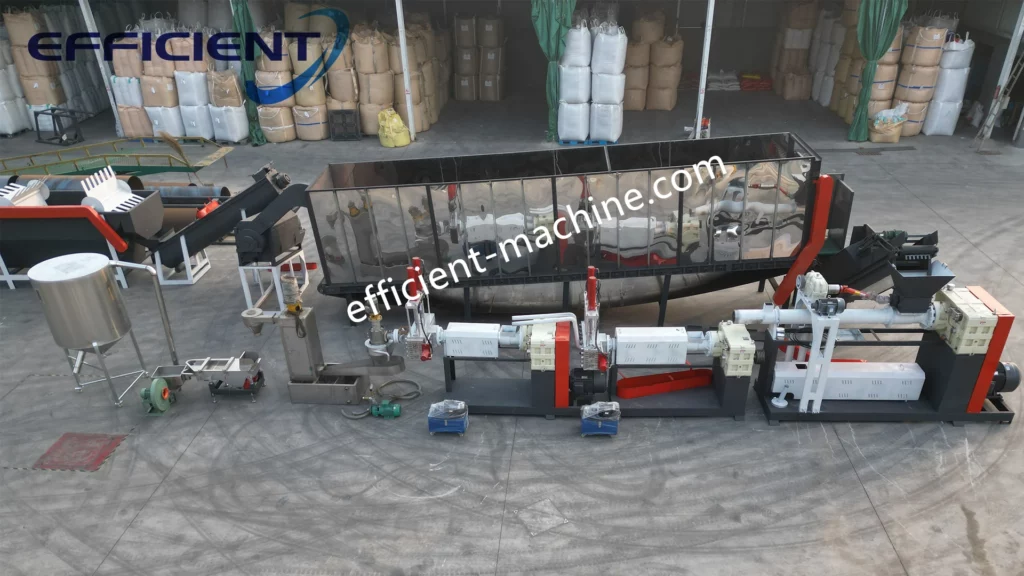مبدأ العمل لآلة الحبيبات البلاستيكية
في عملية إعادة تدوير البلاستيك وإعادة استخدامه، تلعب آلة الحبيبات البلاستيكية دورًا مهمًا كمعدات رئيسية. إنه يحقق إعادة تدوير الموارد عن طريق معالجة النفايات البلاستيكية إلى كريات. ستناقش هذه المقالة مبدأ عمل آلة الحبيبات البلاستيكية بالتفصيل، وتغطي مكوناتها وسير العمل والعوامل المؤثرة، من أجل فهم هذه المعدات المهمة بشكل أفضل.
مكونات آلة الحبيبات البلاستيكية
تتكون آلة تصنيع الحبيبات البلاستيكية بشكل رئيسي من الأجزاء التالية، كل منها له وظيفته الفريدة في عملية العمل:
1. نظام التغذية: مسؤول عن تغذية النفايات البلاستيكية المنظفة إلى آلة الحبيبات. عادةً ما يتم استخدام التغذية الحلزونية أو التغذية بالجاذبية لضمان دخول المواد الخام إلى الرابط التالي بالتساوي.
2. كسارة البلاستيك: قبل الدخول إلى ماكينة الحبيبات، يجب سحق النفايات البلاستيكية إلى جزيئات أصغر للمعالجة اللاحقة. تعمل الكسارة على تفتيت القطع الكبيرة من النفايات البلاستيكية وتقليل حجمها عن طريق تدوير الشفرة.
3. آلة بثق البلاستيك: هذا هو الجزء الأساسي من آلة صنع الحبيبات البلاستيكية. يتكون الطارد من برغي وبرميل ساخنين، حيث يتم تسخين البلاستيك إلى حالة منصهرة. من خلال دوران المسمار، يتم دفع البلاستيك المنصهر إلى القالب.
4. ماكينة سحب البلاستيك: تصميم قالب سحب البلاستيك يحدد شكل وحجم الكريات النهائية. عندما يمر البلاستيك المنصهر عبر القالب، فإنه يبرد ليشكل شرائح بلاستيكية.
5. نظام التبريد: بعد أن يتم بثق الشريط البلاستيكي من القالب، يجب تبريده حتى يصلب. عادة يتم استخدام تبريد الماء أو تبريد الهواء للتبريد.
6. آلة القطع: يتم تقطيع الشرائط البلاستيكية المبردة إلى كريات موحدة للتغليف والنقل اللاحق.
7. نظام التحكم: تم تجهيز ماكينات الحبيبات البلاستيكية الحديثة بأنظمة تحكم ذكية يمكنها مراقبة درجة الحرارة والضغط والسرعة في الوقت الفعلي لضمان استقرار وكفاءة عملية الإنتاج.
سير العمل لآلات الحبيبات البلاستيكية
يمكن تقسيم سير العمل في ماكينات تصنيع الحبيبات البلاستيكية إلى عدة خطوات رئيسية، تمثل كل منها حلقة وصل مهمة لضمان جودة المنتج النهائي:
1. تحضير المواد الخام: أولاً، يجب تنظيف النفايات البلاستيكية لإزالة الشوائب والرطوبة. يتم تغذية النفايات المنظفة إلى نظام التغذية.
2. التكسير: في الكسارة، يتم تقطيع النفايات إلى قطع صغيرة بواسطة الشفرات. تضمن هذه العملية التقدم السلس للمعالجة اللاحقة.
3. البثق الذائب: تدخل الكريات البلاستيكية المسحوقة إلى الطارد. يقوم المسمار المسخن بإذابة البلاستيك عند درجة حرارة عالية ويدفع البلاستيك المنصهر إلى القالب من خلال دوران المسمار.
4. القولبة: يمر البلاستيك المنصهر عبر القالب ويشكل شريطًا بلاستيكيًا مستمرًا بعد التبريد. يحدد تصميم القالب شكل وحجم الكريات، والتي عادة ما تكون أسطوانية أو حبيبية.
5. التبريد: يتم تبريد الشرائط البلاستيكية بسرعة في نظام التبريد وتصل إلى حالة تصلب. عادة ما تؤثر طريقة التبريد على جودة الكريات النهائية.
6. القطع: يتم قطع الشرائط البلاستيكية المبردة إلى كريات صغيرة موحدة بواسطة آلة القطع. هذه الكريات هي المنتج النهائي، جاهز للتغليف والنقل.
7. الفحص والتعبئة: وأخيراً يتم فحص الكريات للتأكد من أن جودتها مطابقة للمعايير، ومن ثم يتم تعبئتها وتجهيزها للتسليم للعملاء.
العوامل المؤثرة على كفاءة العمل لماكينات تصنيع الحبيبات البلاستيكية
أثناء تشغيل آلات الحبيبات البلاستيكية، ستؤثر عوامل متعددة على كفاءة العمل وجودة المنتج، بما في ذلك بشكل رئيسي:
1. خصائص المواد الخام: الأنواع المختلفة من البلاستيك لها اختلافات في درجة حرارة الانصهار والسيولة وما إلى ذلك. إن فهم خصائص المواد الخام واختيار درجة الحرارة والضغط المناسبين هما المفتاحان لضمان كفاءة الإنتاج.
2. التحكم في درجة الحرارة: يعد ضبط درجة حرارة الطارد أمرًا بالغ الأهمية. قد تؤدي درجة الحرارة المرتفعة جدًا إلى تحلل البلاستيك، في حين أن درجة الحرارة المنخفضة جدًا ستؤثر على تأثير الذوبان. التحكم المعقول في درجة الحرارة يساعد على تحسين جودة المنتج.
3. تصميم اللولب: تصميم اللولب له تأثير مباشر على عملية خلط وصهر ونقل البلاستيك. يمكن لتصميم اللولب المناسب أن يحسن كفاءة البثق ويقلل من استهلاك الطاقة.
4. سرعة التبريد: يؤثر تصميم نظام التبريد أيضًا على جودة الكريات. سيؤدي التبريد السريع جدًا أو البطيء جدًا إلى شكل وقوة غير متساوية للكريات.
5. دقة القطع: تؤثر دقة آلة القطع بشكل مباشر على تجانس الكريات البلاستيكية النهائية. القطع الدقيق يمكن أن يضمن جودة المنتج ويعزز القدرة التنافسية في السوق.
صيانة وصيانة ماكينات الحبيبات البلاستيكية
من أجل ضمان التشغيل المستقر وطويل الأمد لآلة الحبيبات البلاستيكية، تعد الصيانة والصيانة المنتظمة ضرورية. تشمل بشكل رئيسي:
1. التنظيف المنتظم: أثناء عملية الإنتاج، سوف تتراكم البقايا البلاستيكية داخل الآلة، ويساعد التنظيف المنتظم على منع الانسداد وتلف المعدات.
2. فحص نظام التشحيم: يجب إعادة تزويد المسمار ونظام النقل بالوقود بانتظام لضمان التشغيل الطبيعي وتقليل التآكل.
3. مراقبة درجة الحرارة: تحقق بانتظام من نظام التحكم في درجة الحرارة للتأكد من أن السخان والمستشعر يعملان بشكل صحيح لمنع درجة الحرارة غير الطبيعية.
4. صيانة الأدوات: يجب استبدال أو شحذ شفرة آلة القطع بانتظام لضمان جودة القطع.
5. فحص المعدات: فحص المعدات بانتظام، والعثور على المشاكل المحتملة والتعامل معها في الوقت المناسب لتجنب التوقف عن العمل.








